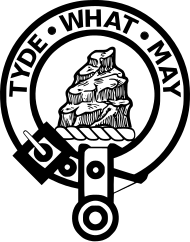Clan Haig
| Clan Haig | |||
|---|---|---|---|
 |
|||
| Motto | Tyde What May | ||
| Chief | |||
 |
|||
| The Right Honourable Alexander | |||
| Earl Haig | |||
| Seat | Bemersyde House | ||
|
|||
Clan Haig is a Lowland Scottish clan.
The thirteenth century poet, Thomas the Rhymer, made the prophecy Tyde what may, what'er betyde, Haig shall be Haig of Bemersyde. Bemersyde has been in the hands of the Haigs for eight hundred years from the founder, Petrus de Haga, to the present chief.Alexander Nisbet asserted that the Haigs were of Pictish or early British extraction. However, it is evident that the name de Haga is Norman.
Petrus de Haga appears as a witness on a charter of Richard de Morville, who was Constable of Scotland from 1162 to 1188, to Dryburgh Abbey. Petrus is mentioned in several charters as Dominus de Bemersyde (Master of Bemersyde) which is evidence that the family were considerable magnates at that time.
de Haga was amongst the nobles who were charged with the apprehension of John de Bisset for the murder of the Earl of Atholl in 1242.
The Haig Barons of Bemersyde swore fealty to Edward I of England and appear on the Ragman Rolls in 1296. However, later they strongly supported the struggle for Scottish Independence and fought for William Wallace at the Battle of Stirling Bridge in 1297. The sixth Haig Laird followed Robert the Bruce to the Battle of Bannockburn in 1314 even though at the time he was only seventeen years old. He was later killed at the Battle of Halidon Hill in 1333.
In 1449 Gilbert Haig was a commander in the Scottish host that defeated the Earl of Northumberland at the Battle of Sark. Gilbert also opposed the rising power of the Clan Douglas family. Gilbert's son, James Haig, was an adherent of James III of Scotland. When James III was murdered in 1488, Haig was forced into hiding until he could make peace with the young James IV of Scotland.
...
Wikipedia
